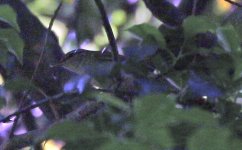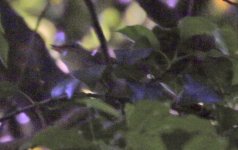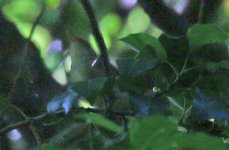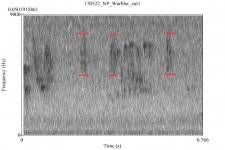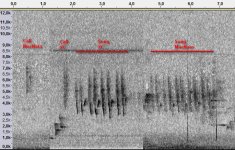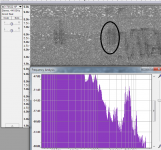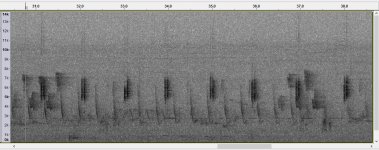In my usual spot in Nara City on 22 May, I found this warbler.
Neither the photos nor the recording are good, but I'm hoping that the experts of BF will be able to put the two together to give me an ID.
On migration in autumn and spring, we get a few birds of the Arctic Warbler spp in the small area I go to regularly (circumference about 3km). It is about 100m asl, and has light woodland and water; it is attached to woodlands that go a few hundred metres higher.
When the Arctic Warbler split came to my awareness, I started trying to record the birds that I saw - when they made a noise, which they mostly don't. And I've never had any song, just the basic call. All the birds I have recorded over the past three years (maybe ten in total) have been Kamchatka Leaf Warblers (O-mushikui; Big Warbler in Japanese). This has a strong dzit sound of one syllable.
Yesterday's bird is very late for our location. I am sure that this sound is from this bird because the sound came first, and that's why I looked for the bird. There were a lot of other bird sounds - principally a Narcissus Flycatcher which seems to have settled in to breed (a first in this spot) and Japanese Bush Warblers, as well as Bulbuls and White-eyes; and for some of the time there was a helicopter. Thus, although with my voice recorder I got about one or two minutes while this bird was sounding (that I could distinguish with my ears), only a few seconds of the recording had clearly distinguishable sound from this bird.
On the attached recording, after a Bulbul screech, you can hear the warbler call three times: and it is clearly a two-syllable, zit-zit sound, and softer than the Kamchatka Warbler (examinandus) sound.
I thought this might be the Japanese Leaf Warbler (xanthodryas), but I have downloaded recordings of all three members of the Arctic Warbler split, and they all seem to have a one-syllable call.
I think I have also seen a Sakhalin Leaf Warbler (Pale-legged split) in this spot several years ago, but this also has a different call.
If anyone can help, I will be very grateful. I don't think it's anything rare, but I really don't think it can be Kamchatka Leaf as all the other birds I have recorded had basically the same call.
Neither the photos nor the recording are good, but I'm hoping that the experts of BF will be able to put the two together to give me an ID.
On migration in autumn and spring, we get a few birds of the Arctic Warbler spp in the small area I go to regularly (circumference about 3km). It is about 100m asl, and has light woodland and water; it is attached to woodlands that go a few hundred metres higher.
When the Arctic Warbler split came to my awareness, I started trying to record the birds that I saw - when they made a noise, which they mostly don't. And I've never had any song, just the basic call. All the birds I have recorded over the past three years (maybe ten in total) have been Kamchatka Leaf Warblers (O-mushikui; Big Warbler in Japanese). This has a strong dzit sound of one syllable.
Yesterday's bird is very late for our location. I am sure that this sound is from this bird because the sound came first, and that's why I looked for the bird. There were a lot of other bird sounds - principally a Narcissus Flycatcher which seems to have settled in to breed (a first in this spot) and Japanese Bush Warblers, as well as Bulbuls and White-eyes; and for some of the time there was a helicopter. Thus, although with my voice recorder I got about one or two minutes while this bird was sounding (that I could distinguish with my ears), only a few seconds of the recording had clearly distinguishable sound from this bird.
On the attached recording, after a Bulbul screech, you can hear the warbler call three times: and it is clearly a two-syllable, zit-zit sound, and softer than the Kamchatka Warbler (examinandus) sound.
I thought this might be the Japanese Leaf Warbler (xanthodryas), but I have downloaded recordings of all three members of the Arctic Warbler split, and they all seem to have a one-syllable call.
I think I have also seen a Sakhalin Leaf Warbler (Pale-legged split) in this spot several years ago, but this also has a different call.
If anyone can help, I will be very grateful. I don't think it's anything rare, but I really don't think it can be Kamchatka Leaf as all the other birds I have recorded had basically the same call.





